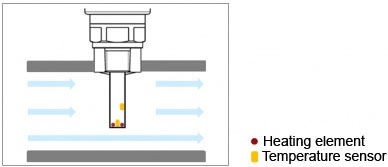-
Thermistor is a semiconductor based (metallic compounds including oxides such as manganese, copper, cobalt and nickel as well as single-crystal semiconductors silicon silicon and germanium) temperature sensor.
- They are commonly packaged in a thermally conductive glass bead or disk with two metal leads.
- It is a NTC (negative temperature coefficient) device i.e. its resistance decreases with rise in temperature. Although PTC Thermistors are also available, it is the NTC type which has gained wide attention.
- When the doping is very heavy, the semiconductor achieves metallic properties and shows a positive temperature coefficient over a limited temperature range.
- Thermistor is highly non-linear and one of the most sensitive temperature sensor. The high sensitivity of thermistor allows it to detect very small change in temperature which otherwise would not be possible with Themocouple and RTD.
Listed below are the features of Thermistor one need to consider:
(1) Very high sensitivity: It yields higher resolution in temperature measurement
(2) High sensitivity allows use of small mas and thus fast response and low measurement error
(3) Non-linear response
(4) Small geometry allows them to be easily integrate with electronic circuitry
The Resistance-temperature relationship of a Thermistor is governed by the equation
Rt = Ro{exp[B(1/T - 1/To)]}
Rt = Thermistor Resistance at T Kelvin
Ro = Thermistor resistance at To Kelvin
B= Temperature coefficient, ~3000-4000K
The above curve shows characteristics of a Thermistor with resistance 10k at 25 degC.
Relative sensitivity of Thermistor is:
B can be calculated from the NTC thermistor resistance at two reference temperature T1 and T2
Because of its high sensitivity and large resistance, it is not required to use 4-wire method (Kelvin's Bridge configuration) for Thermistor resistance measurement. A lead wire of 20 Ohm resistance would only cause less than 0.05 deg C error in measurement at 25 deg C which is insignificant for most practical purposes.
Lets do some math to validate above statement.
1/T - 1/To = (1/B)log(Rt/Ro)
dT/dRt = (T*T)/(B*Rt)
dT = 298*298*20/(3500*10000) = 0.05deg C
There is also a 3-parameter model of Thermistor given by the following equation known as Steinhart and Hart equation:
Linearizing Thermistor response
One disadvantage of using Thermistor is its non-linear behaviour. Its response can be linearized by adding a fixed shunt resistor but linearity comes at the cost of reduced sensitivity.
The value of the fixed resistor can be calculated from the following equation.
where RT1 is the thermistor resistance at T1, the lowest temperature in the measurement range, RT3 is the thermistor resistance at T3, the highest temperature in the range, and RT2 is the thermistor resistance at T2, the midpoint, T2 = (T1 + T3)/2.
Interfacing with Data acquisition system:
As most data acquisition systems accept voltage input, it is recommended to convert change in voltage to corresponding change in voltage. A voltage divider network consisting of Thermistor and precision resistor is generally used.The accuracy of reference voltage also affects the accuracy of measurement.
Usually the value of R is taken to be equal to Thermistor resistance @25 degC. To avoid loading, the output voltage is fed to a voltage buffer.
Questions
GATE-2007
GATE-2008
GATE-2009
GATE-2014
A thermistor has a resistance of 1 kΩ at temperature 298 Kand 465 Ω at temperature 316 K. The temperature sensitivity in /K[i.e. (1/R)(dR/dT), where R is the resistance at the temperature T(in K)], of this thermistor at 316 K is ___________.
























